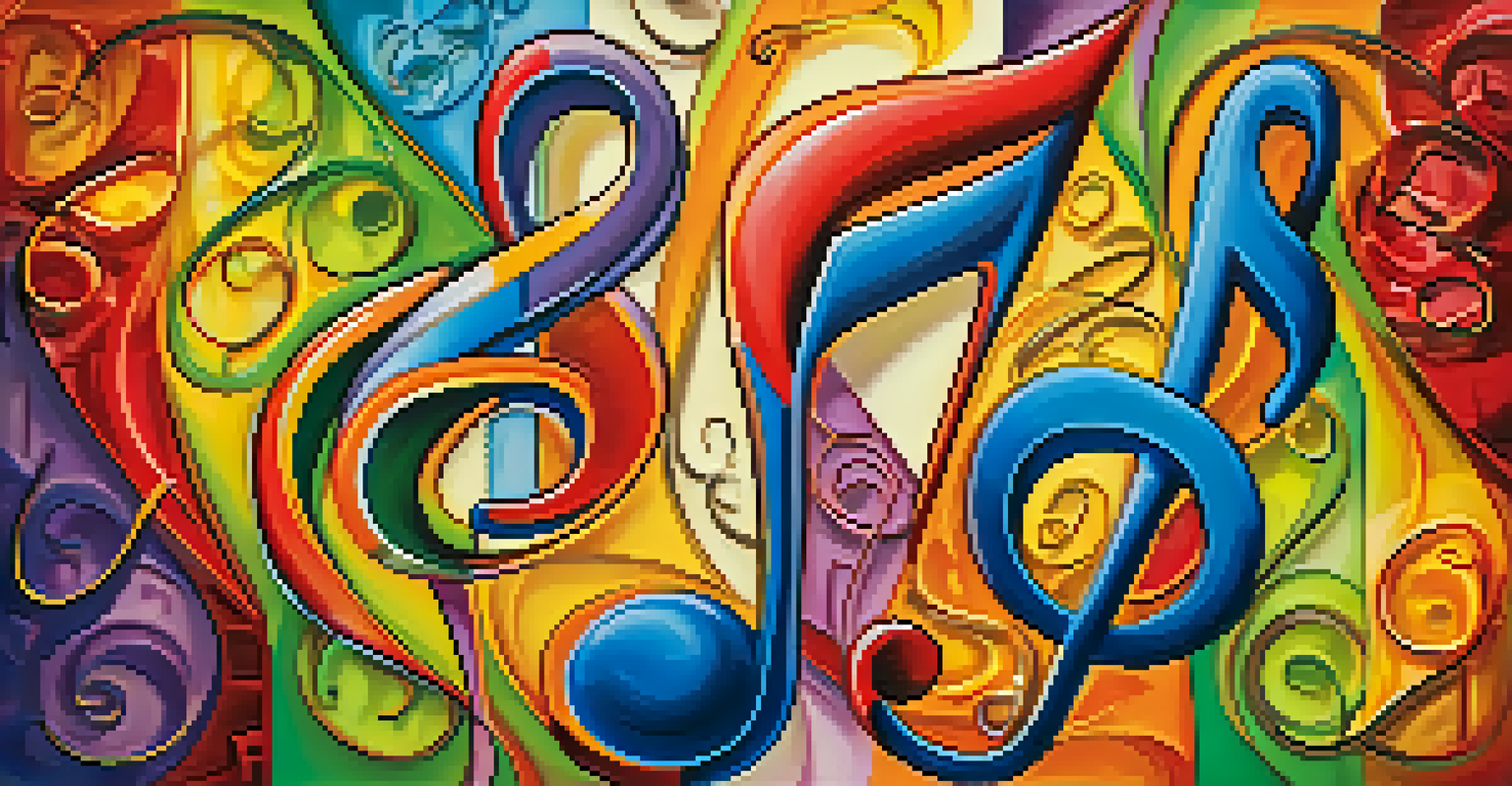The Use of Symbols in Music Notation: A Comprehensive Guide

Understanding the Basics of Music Notation Symbols
Music notation is a visual representation of music, using symbols to convey pitch, rhythm, and dynamics. At its core, it provides musicians with a way to communicate their ideas effectively. Whether you’re reading a score or composing your own piece, these symbols serve as the foundation of musical language.
Music can change the world because it can change people.
Each symbol in music notation has a specific meaning, much like words in a sentence. For instance, a quarter note indicates a particular duration of sound, while rests signify silence. Understanding these basics is crucial for anyone looking to delve deeper into the world of music.
As you become familiar with these symbols, you'll find that they not only enhance your reading skills but also enrich your overall musical experience. It’s like learning a new language that opens up a world of creativity and expression.
The Role of Pitch and Clefs in Music Notation
Pitch is one of the most important elements in music, and clefs play a vital role in determining how we read it. A clef, such as the treble or bass clef, indicates which notes correspond to which lines and spaces on the staff. This helps musicians understand the range and register of the music they are playing.

For example, the treble clef is often used for higher-pitched instruments like the flute or violin, while the bass clef is used for lower-pitched instruments, such as the cello or bassoon. Each clef provides a different perspective on the music, guiding the performer in their interpretation.
Music Notation Basics Explained
Understanding music notation symbols is essential for effective communication and expression in music.
By mastering clefs, musicians can navigate various pieces of music with ease, allowing them to express themselves more freely. It’s like having a map that directs you through the nuances of musical landscapes.
Rhythmic Symbols: Understanding Duration in Music
Rhythm is the heartbeat of music, and understanding rhythmic symbols is essential for accurate performance. Notes and rests come in various shapes and sizes, each representing different durations. For instance, a whole note holds for four beats, while an eighth note is played for half a beat.
Without music, life would be a mistake.
In addition to these basic note values, rhythmic symbols can also include ties and dots, which modify the duration of notes. A tied note means to hold the sound for the combined duration of both notes, while a dot adds half of the original value to the note. These subtle changes can drastically affect the flow of the music.
By grasping these rhythmic symbols, musicians can bring dynamic energy to their performances. It's much like the tempo of a conversation; the rhythm keeps the dialogue engaging and lively.
Dynamics: Expressing Emotion Through Notation Symbols
Dynamics in music notation indicate the volume at which notes should be played, helping to convey emotion and intensity. Symbols like 'p' for piano (soft) and 'f' for forte (loud) guide musicians in expressing the mood of a piece. Understanding these dynamics can transform a performance from plain to profoundly moving.
Additionally, symbols like crescendo (gradually getting louder) and diminuendo (gradually getting softer) provide direction for the performer to build tension or release it. These elements are crucial for creating contrast and keeping the listener engaged.
The Importance of Dynamics
Dynamics in music notation guide performers in conveying emotion, transforming their interpretations into impactful experiences.
By incorporating dynamics into their playing, musicians can breathe life into the music, similar to how an actor brings depth to a character. It’s all about the nuances that make the performance memorable.
Articulation Symbols: The Nuances of Playing Technique
Articulation symbols in music notation indicate how notes should be played, adding texture and character to a piece. These symbols include staccato (short and detached notes), legato (smooth and connected), and accents (emphasizing a note). Each articulation provides a different flavor to the music, much like seasoning in a dish.
Understanding these articulations allows musicians to interpret music more fully, enabling them to express their unique style. For instance, a staccato passage can create a playful atmosphere, while legato can evoke a sense of longing.
By mastering articulation symbols, musicians can enhance their expressiveness, making their performances truly captivating. It's this attention to detail that transforms notes into an emotional experience for the audience.
The Importance of Key Signatures in Music Notation
Key signatures are essential symbols in music notation that indicate the key of a piece, guiding musicians on which notes to play sharp or flat. A key signature appears at the beginning of a staff and can drastically alter the character of the music. For instance, a piece in D major has two sharps, giving it a bright, uplifting feel.
Understanding key signatures allows musicians to anticipate the tonal center and adjust their playing accordingly. This knowledge not only aids in sight-reading but also helps in improvisation and composition.
Key Signatures Shape Music's Feel
Key signatures are crucial for musicians, as they indicate the tonal center and influence the character of a musical piece.
By recognizing and interpreting key signatures, musicians can navigate through various musical styles with confidence. It’s like knowing the rules of a game; once you understand them, you can play strategically and creatively.
Notation for Different Musical Genres: A Symbolic Overview
Different musical genres often employ unique symbols and notational styles, reflecting their distinct characteristics. For instance, jazz notation may include chord symbols and lead sheets, allowing for more improvisation, while classical music typically uses detailed scores with extensive notation.
Understanding these genre-specific symbols can enhance a musician's versatility. For example, a classical pianist may need to adapt to reading jazz charts, which require a different approach to rhythm and harmony.

By familiarizing themselves with various notation styles, musicians can broaden their repertoire and adapt to different performance settings. It's like learning to dance in multiple styles; each one adds to your overall skill set.